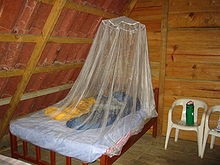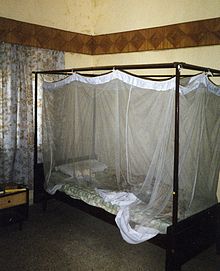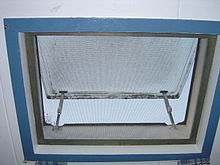- Mosquito net
-
A mosquito net offers protection against mosquitos,[1] flies, and other insects, and thus against diseases such as malaria, dengue fever, yellow fever, and various forms of encephalitis, including the West Nile virus,[2] if used properly and especially if treated with an insecticide, which can double effectiveness. The fine, see-through, mesh construction stops many insects from biting and disturbing the person using the net. The mesh is fine enough to exclude these insects, but it does not completely impede the flow of air.
Contents
History
Mosquito netting has a long history. Though use of the term dates from the mid-18th century,[1] use of mosquito nets has been dated to prehistoric times. It is said that Cleopatra, Queen of Egypt, also slept under a mosquito net.[3] Mosquito nets were used during the malaria-plagued construction of the Suez Canal.[3]
Construction
Mosquito net can be made from cotton, polyethylene, polyester, or nylon.[4] A mesh size of 1.2 mm stops mosquitoes, and smaller, such as 0.6 mm, stops other biting insects such as biting midges/no-see-ums.[5]
A mosquito bar is an alternate form of a mosquito net. It is constructed of a fine see-through mesh fabric mounted on and draped over a box-shaped frame. It is designed to fit over an area or item such as a sleeping bag to supply protection from insects. A mosquito bar is designed for used while camping outdoors.[citation needed] {{ The mesh is woven tightly enough to stop insects from entering but loosely enough to not interfere with air flow and the occupant's capability to take in oxygen. The frame is usually self-supporting or free standing although it can be designed to be attached from the top to an alternative support such as tree limbs.[citation needed]
Usage
Mosquito nets are often used where malaria or other insect-borne diseases are common, especially as a tent-like covering over a bed. For effectiveness, it is important that the netting not have holes or gaps large enough to allow insects to enter. Because an insect can bite a person through the net, the net must not rest directly on the skin.
Mosquito netting can be hung over beds, from the ceiling or a frame, built into tents, or installed in windows and doors. When hung over beds, rectangular nets provide more room for sleeping without the danger of netting contacting skin, at which point mosquitoes may bite through untreated netting.[6]
Insecticide treated nets
Mosquito nets treated with insecticides—known as insecticide treated nets (ITNs) or bednets -- were developed in the 1980s for malaria prevention. Newer, longer lasting insecticide nets are starting to replace ITN's in many countries(LLIN).Insecticide-treated nets (ITN) are estimated to be twice as effective as untreated nets,[7] and offer greater than 70% protection compared with no net.[8] These nets are dip treated using a synthetic pyrethroid insecticide such as deltamethrin or permethrin which will double the protection over a non-treated net by killing and repelling mosquitoes.
The distribution of mosquito nets or bednets impregnated with insecticides such as permethrin or deltamethrin has been shown to be an extremely effective method of malaria prevention, and it is also one of the most cost-effective methods of prevention. These nets can often be obtained for around $2.50–$3.50 (2–3 euros) from the United Nations, the World Health Organization (WHO), and others. ITNs have been shown to be the most cost-effective prevention method against malaria and are part of WHO’s Millennium Development Goals (MDGs).[9] Generally LLIN's are purchased by donor groups like the Bill and Melina Gates Foundation and distributed through in country distribution networks.
For maximum effectiveness, the nets should be re-impregnated with insecticide every six months. This process poses a significant logistical problem in rural areas. New technologies like Olyset or DawaPlus allow for production of long-lasting insecticidal mosquito nets (LLINs), which release insecticide for approximately 5 years,[10] and cost about US$5.50. ITNs protect people sleeping under the net and simultaneously kill mosquitoes that contact the net. Some protection is also provided to others by this method, including people sleeping in the same room but not under the net. However, mathematical modeling has suggested that disease transmission may be exacerbated after bed nets have lost their insecticidal properties under certain circumstances.[11] Although ITN users are still protected by the physical barrier of the netting, non-users could experience an increased bite rate as mosquitoes are deflected away from the non-lethal bed net users.[11] The modeling suggests that this could increase transmission when the human population density is high or at lower human densities when mosquitoes are more adept at locating their blood meals.[11]
While some experts argue that international organizations should distribute ITNs and LLINs to people for free in order to maximize coverage (since such a policy would reduce price barriers), others insist that cost-sharing between the international organization and recipients would led to greater usage of the net (arguing that people will value a good more if they pay for it). Additionally, proponents of cost-sharing argue that such a policy ensures that nets are efficiently allocated to those people who most need them (or are most vulnerable to infection). Through a "selection effect", they argue, those people who most need the bed nets will choose to purchase them, while those less in need will opt out.
However, a randomized controlled trial study of ITNs uptake among pregnant women in Kenya, conducted by economists Pascaline Dupas and Jessica Cohen, found that cost-sharing does not necessarily increase the usage intensity of ITNs nor does it induce uptake by those most vulnerable to infection, as compared to a policy of free distribution.[12][13] In some cases, cost-sharing can actually decrease demand for mosquito nets by erecting a price barrier. Dupas and Cohen’s findings support the argument that free distribution of ITNs can be more effective than cost-sharing in both increasing coverage and saving lives. In a cost-effectiveness analysis, Dupas and Cohen note that cost-sharing is at best marginally more cost-effective than free distribution, but free distribution leads to many more lives saved. [12]
The researchers base their conclusions about the cost-effectiveness of free distribution on the proven spillover benefits of increased ITN usage.[14] ITNs not only protect the individuals or households that use them, but they also protect people in the surrounding community in one of two ways. [15] First, ITNs kill adult mosquitos infected with the malaria parasite directly which increases their mortality rate and can therefore decrease the frequency in which a person in the community is bit by an infected mosquito. [16] Second, certain malaria parasites require days to develop within the salivary glands of the vector mosquito. Plasmodium falciparum for example, the parasite that is responsible for the majority of deaths in sub-Saharan Africa, takes 8 days to mature and therefore malaria transmission to humans does not take place until approximately the 10th day, although would have required blood meals at intervals of 2 to 5 days [17] By killing mosquitoes prior to maturation of the malaria parasite, ITNs can reduce the number of encounters of infected mosquitos with humans. [18]
When a large number of nets are distributed in one residential area, their chemical additives help reduce the number of mosquitoes in the environment. With fewer mosquitoes in the environment, the chances of malaria infection for recipients and non-recipients are significantly reduced. (In other words, the importance of the physical barrier effect of ITNs decreases relative to the positive externality effect[clarification needed] of the nets in creating a mosquito-free environment when ITNs are highly concentrated in one residential cluster or community.)
Unfortunately, standard ITNs must be replaced or re-treated with insecticide after six washes and, therefore, are not seen as a convenient, effective long-term solution to the malaria problem.[19] As a result, the mosquito netting and pesticide industries developed so-called long-lasting insecticidal mosquito nets (LLINs), which also use pyrethroid insecticides. There are two types of LLINs, one which is polyester netting and the insecticide is bound to the external surface of the netting fiber using a resin and another which incorporates the insecticide into a polyethylene fiber which then releases the insecticide slowly over 5 years. Both types can be washed at least 20 times but physical durability will vary, a survey carried out in Tanzania concluded that effective life of polyester nets was 2 to 3 years (Erlanger et al., 2004, Med Vet Entomol 18: 153-160), with polyethylene LLINs there is data to support > 5 years life with trials in showing nets which were still effective after 7 years (Tami, A et al. Malaria Journal 2004, 3:19). When calculating the cost of LLINs for large scale malaria prevention campaigns the cost should be divided by the number of years of expected life, hence a slightly more expensive net may be cheaper over time. In addition the logistical costs of replacing nets should be added to the calculation.
Scientific trials of ITNs
A review of 22 randomized controlled trials of ITNs[20] found (for Plasmodium falciparum malaria) that ITNs can reduce deaths in children by one fifth and episodes of malaria by half.
More specifically, in areas of stable malaria "ITNs reduced the incidence of uncomplicated malarial episodes by 50% compared to no nets, and 39% compared to untreated nets" and in areas of unstable malaria "by 62% compared to no nets and 43% compared to untreated nets". As such the review calculated that for every 1000 children protected by ITNs, 5.5 lives would be saved each year.
Alternatives
Mosquito nets do reduce air flow to an extent and sleeping under a net is hotter than sleeping without one, which can be uncomfortable in tropical areas without air-conditioning.
One alternative for reducing mosquito bites is to use a fan to increase air flow, as mosquitoes prefer still air; however, this is far less effective and mosquito netting is preferable in areas with insect-borne diseases.[citation needed]
Another alternative is to apply an insect repellent to the skin; this also may be less effective (reducing rather than eliminating bites), more expensive, and may pose health risks with long-term use.
Another alternative is to wear clothing treated with insect repellency. Insect repellent clothing offers the advantage of long lasting protection, requiring no re-application. This protection is usually odorless and invisible, and, unlike traditional insect repellents, the repellency is near your skin, instead of on it, which can help alleviate concerns about overuse or misuse of insect repellent.
See also
References
- ^ a b Oxford English Dictionary (draft ed.). Oxford University Press. 2009.
- ^ "All Mosquito Netting Info". http://www.mosquito-netting.com/. Retrieved 2009-10-27.
- ^ a b "History of Malaria Control". http://www.malariasite.com/malaria/history_control.htm. Retrieved 2009-10-27.
- ^ "World Health Organization: Annex VII : Procedure for Treating Mosquito Nets and curtains". http://searo.who.int/en/Section10/Section332/Section554_2554.htm. Retrieved 2009-10-27.
- ^ "Mosquito Netting Criteria". http://www.mosquito-netting.com/mosquito-netting.html. Retrieved 2009-10-27.
- ^ "Travel Health Help: Mosquito Nets". http://www.travelhealthhelp.com/mosquito-nets.html. Retrieved 2009-10-27.
- ^ Hull, Kevin. (2006). "Malaria: Fever Wars". PBS. http://www.wgbh.org:81/cgi-bin/nph-algs.cgi/000000A/http://www.wgbh.org/schedules/program-info?program_id=2682027&episode_id=2682029.
- ^ Bachou H, Tylleskär T, Kaddu-Mulindwa DH, Tumwine JK (2006). "Bacteraemia among severely malnourished children infected and uninfected with the human immunodeficiency virus-1 in Kampala, Uganda". BMC Infect. Dis. 6: 160. doi:10.1186/1471-2334-6-160. PMC 1660577. PMID 17090299. http://www.pubmedcentral.nih.gov/articlerender.fcgi?tool=pmcentrez&artid=1660577.
- ^ "World Health Organization: MDG 6: combat HIV/AIDS, malaria and other diseases". http://www.who.int/topics/millennium_development_goals/diseases/en/index.html. Retrieved 2011-10-28.
- ^ [dead link] "New Mosquito Nets Could Help Fight Malaria in Africa". http://www.voanews.com/english/archive/2004-11/2004-11-23-voa30.cfm?CFID=15461499&CFTOKEN=28007413[dead link].
- ^ a b c Yakob, Laith; Guiyun Yan (2009). "Modeling the Effects of Integrating Larval Habitat Source Reduction and Insecticide Treated Nets for Malaria Control". PLoS ONE (Public Library of Science) 4 (9). doi:10.1371/journal.pone.0006921.
- ^ a b Jessica Cohen, Pascaline Dupas (February 2010). "Free Distribution or Cost-Sharing? Evidence from a Randomized Malaria Prevention Experiment" (PDF). Quarterly Journal of Economics 125 (1): 24. http://poverty-action.org/sites/default/files/Dupas%20Free_Distribution_vs__Cost-Sharing_10.15.07.pdf.
- ^ "Free Distribution or Cost-Sharing: Evidence from a Malaria Prevention Experiment in Kenya". Innovations for Poverty Action (IPA). http://poverty-action.org/project/bednets. Retrieved 2010-02-18.
- ^ Hawley, William A. et al. (2003). "Community-Wide Effects of Permethrin-Treated Bed Nets on Child Mortality and Malaria Morbidity in Western Kenya" (PDF). American Journal of Tropical Medicine and Hygiene 68(Suppl. 4). http://www.ajtmh.org/cgi/reprint/68/4_suppl/121.pdf. Retrieved 2010-02-18.
- ^ Maxwell CA, Msuya E, Sudi M, Njunwa KJ, Carneiro IA, et al. (2002) Effect of community-wide use of insecticide-treated nets for 3–4 years on malarial morbidity in Tanzania. Tropical Medicine and International Health, 7: 1003–1008.
- ^ Killeen GF, Smith TA (2007) Exploring the contributions of bednets, cattle, insecticides and excito-repellency to malaria control: A deterministic model of mosquito host-seeking behaviour and mortality. American Journal of Tropical Medicine and Hygiene.
- ^ Smith DL, McKenzie FE (2004) Statics and dynamics of malaria infection in Anopheles mosquitoes. Malaria Journal 3: 13.
- ^ Killeen GF, Smith TA (2007) Exploring the contributions of bednets, cattle, insecticides and excito-repellency to malaria control: A deterministic model of mosquito host-seeking behaviour and mortality. American Journal of Tropical Medicine and Hygiene
- ^ "Insecticide-Treated Mosquito Nets" (PDF). WHO. p. 5. http://apps.who.int/malaria/docs/itn/ITNspospaperfinal.pdf.
- ^ Lengeler C. (2004) Insecticide-treated bed nets and curtains for preventing malaria. The Cochrane Database of Systematic Reviews. Issue 2. [1]
External links
Categories:- Insect-borne diseases
- Insect repellents
Wikimedia Foundation. 2010.




